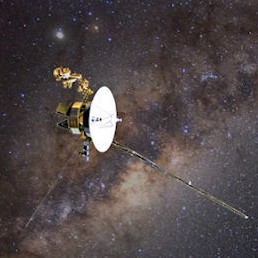Voyager 1 PWS audio
Voyager 2 PWS audio
The above links take you to lists of time intervals of Voyager plasma wave waveform data. Each link in each list takes you to a page of thumbnail images with spectrograms derived from raw measurements. Clicking on one of the thumbnails retrives a larger plot with links for accessing descriptive information or for listening to the audio version of the data. The audio is a direct playback of the original measurements at the rate they were taken.
This set comprises all available waveform data from the Voyager project. Occasionally the very newest data will be excluded pending publication of new results.
The PWS wideband waveform instruments on the two Voyager spacecraft sample the electric field on the dipole wire antenna at a rate of 28800 4-bit samples per second, using an automatic gain control. Consequently, the audio is just slightly better than telephone quality. Packets of 1600 samples are acquired, separated by the equivalent of 128 missing samples. Running these packets together results in the playback taking less than real-time (by a factor of 1600 / 1728), and also introduces a slight audible flutter. The amplitudes at the edges of these packets have been smoothed to reduce this flutter, but this is the only modification to the signal.
Other than the packet edge rounding mentioned above, no other noise has been removed from these recordings. Several sources of on-board spacecraft noise remain. The constant tone at 2.4kHz is caused by the spacecraft power supply. The occasional sounds like someone pounding a drum or thumping on an oil barrel are due to either a stepper motor on another instrument or to spacecraft attitude thruster firings. The tones with harmonics that build slowly and end abruptly and appear as multiple horizontal lines in the spectrogram are due to interference from other science instruments onboard. Most remaining signals are the genuine "sounds" of space.
Now, what do we mean by "sounds" of space? First, during planetary encounters, the sounds are not typically produced at the planet itself, but in the magnetosphere surrounding the planet or, for example, from the interaction of the supersonic solar wind colliding with the bow shock ahead of the planet's magnetosphere. These waves are not the same as the pressure waves in the atmosphere that we normally think of as sound. However, they do have some similarities. Even though space is an excellent vacuum, it is "filled" with particles with a density of typically a few to several hundred per cubic centimeter near planets. Most of these are charged and constitute what we call plasma. Being charged, these particles interact with each other without the need to collide as they do in the atmosphere. Moving charged particles both produce electromagnetic fields and waves and also are moved by electromagnetic fields and waves generated elsewhere. These are "plasma waves". Many of these interactions occur at frequencies that are audible to humans. This doesn't mean that a human ear could hear them in space -- the pressures are far too small -- but it is conceivable that an ultra-sensitive microphone could measure them. In practice, however, it is far easier to measure the oscillations in the accompanying electric and magnetic fields with antennas, and that is just what we do. To produce sound we can hear, we simply do the moral equivalent of hooking our antennas up to an amplifier in order to drive speakers. Plasma waves can be considered "space audio".
For a more rigorous introduction to plasma waves, see the tutorial article by Dr. William Kurth.
 The University of Iowa
The University of Iowa



